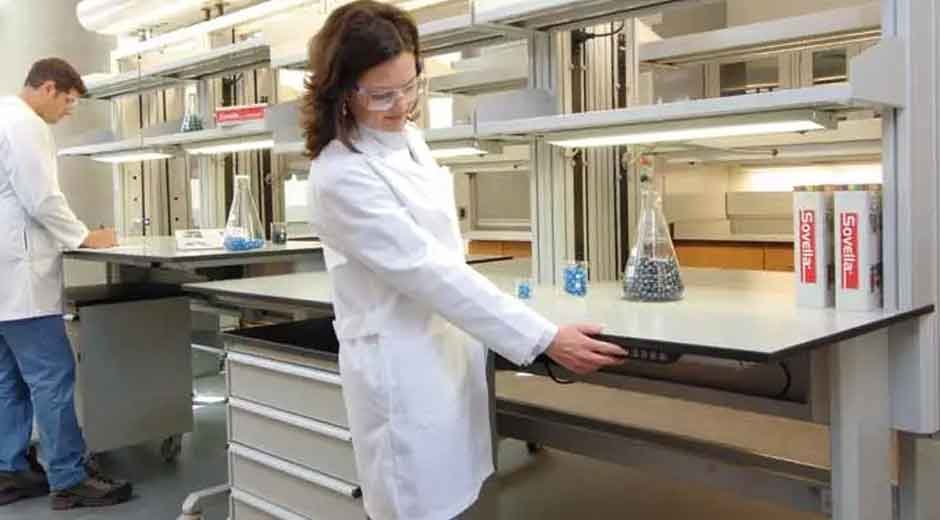Skip to the good bit
ToggleLaboratory tables are the backbone of any school science lab, providing not just a work surface but a foundation for hands-on education, experimentation, and discovery. Whether in high schools, middle schools, or collegiate environments, the right laboratory tables can significantly impact the functionality, safety, and durability of a learning space. For schools aiming to modernize or expand their lab facilities, understanding what makes a good laboratory table is critical for long-term success.
Why Laboratory Tables Matter in School Environments
Laboratory tables are not just furniture; they are essential infrastructure. These tables must withstand chemical spills, heat, heavy equipment, and constant use by students. More importantly, they need to support a learning environment that encourages safety, collaboration, and efficiency.
In a school setting, lab tables endure far more than ordinary classroom desks. They’re exposed to corrosive substances, repetitive impacts, and varying temperature conditions. This is why quality and construction materials are top priorities for any institution outfitting a science lab. A well-chosen laboratory table minimizes maintenance and enhances safety while maximizing performance.
Key Features of High-Quality Laboratory Tables
When schools shop for laboratory tables, a few essential features set the best ones apart. One of the most crucial considerations is the table surface. Ideally, the surface should be made of chemical-resistant laminate, epoxy resin, or phenolic resin, all of which offer strong protection against acids, solvents, and heat. Epoxy resin tops, for instance, are particularly effective for wet labs due to their water resistance and longevity.
Another important feature is frame strength. Laboratory tables should be made with heavy-gauge steel frames or solid hardwood legs that provide stability under the weight of lab equipment like microscopes, Bunsen burners, and centrifuges. Tables with reinforced corners and tamper-resistant hardware are particularly suitable for school settings, where durability is non-negotiable.
Mobility and modularity are also becoming more popular, with many schools preferring tables on lockable casters for easy reconfiguration of the lab layout. Adjustable-height tables add further flexibility, making labs more accessible and compliant with ADA standards.
Types of Laboratory Tables for Different Educational Needs
Not all lab tables are created equal, and choosing the right type depends on how the lab is used. Fixed tables are ideal for traditional labs focused on chemistry or biology, where stability is critical. These are often paired with built-in sinks and gas fixtures for more complex experiments.
Mobile lab tables offer schools greater adaptability. These are particularly useful in multipurpose science classrooms or STEM labs, where the room may shift functions throughout the day. Schools investing in flexible learning environments will benefit from tables that can be moved and rearranged easily without compromising safety.
Computer-integrated lab tables are another emerging option, especially in advanced placement or high school labs focused on data analysis and digital learning. These tables come with cable management systems and monitor arms, combining physical science experiments with digital observation.
Safety Considerations in School Science Labs
Safety is a primary concern when it comes to choosing laboratory tables. Rounded corners, chemical-resistant coatings, and non-slip feet are a few features that enhance student safety. Many modern tables are also designed to accommodate emergency shut-off switches or are height-matched to fume hoods and ventilation systems for safe chemical handling.
Tables with integrated storage also support lab safety by reducing clutter and keeping hazardous materials out of reach when not in use. Some tables include locking drawers and cabinets that comply with safety regulations, which is especially important in middle and high school environments.
Durability and Cost Efficiency
While budget is often a constraint for schools, cutting corners on laboratory tables can lead to higher long-term costs. Tables made from cheaper materials may show wear and tear within a year or two, requiring replacement or repair that quickly outweighs the initial savings.
Investing in durable, high-quality laboratory tables pays off by reducing maintenance needs and increasing the lifespan of the lab infrastructure. Additionally, many school outlets offer volume discounts or bundled pricing for full-lab setups, making it easier to outfit an entire room within budget.
The Role of Design in Student Engagement
An often-overlooked aspect of laboratory tables is their contribution to student engagement. Well-designed tables promote interaction, collaboration, and curiosity. Arranging tables in pods or clusters can support group work, while linear rows work better for teacher-led instruction.
Color and aesthetics matter too. Clean, modern table designs in neutral or school-themed colors make the lab feel inviting and up-to-date, which can influence students’ attitudes toward science and technology. By creating a well-equipped, visually appealing lab, schools send a clear message that STEM education is a priority.
What to Look for When Buying Laboratory Tables
When choosing laboratory tables, schools should consider:
- Surface material: Is it resistant to chemicals, heat, and moisture?
- Construction quality: Are the frames made of hardwood or powder-coated steel?
- Adaptability: Does the table support different layouts or subjects?
- Safety features: Are there rounded edges, anti-slip features, or integrated storage?
- Maintenance needs: How easy is it to clean and repair?
- Warranty and vendor support: Is the product backed by a reliable warranty or service plan?
Schools that take the time to evaluate these factors will be better positioned to build labs that are not only safe and functional but also inspiring spaces for future scientists.
Final Thoughts on Laboratory Tables for Schools
Laboratory tables play a pivotal role in shaping the educational experience within school science labs. From durability and safety to design and adaptability, each element contributes to a space that fosters discovery, experimentation, and learning. For schools upgrading their science departments, choosing the right laboratory tables is an investment in both infrastructure and student success.
By selecting tables that align with modern educational needs and safety standards, schools ensure their labs remain functional and engaging for years to come. Whether outfitting a brand-new facility or renovating an older one, the right laboratory tables make all the difference.







